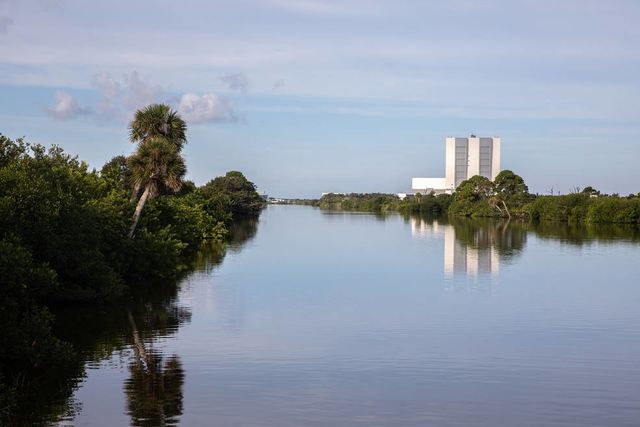IRLNews:Kennedy Space Center Develops Indian River Lagoon Health Initiative Plan
“The lagoon is considered to be one of the most biologically diverse estuaries in North America,” said Nick Murdock, Environmental Management Branch (EMB) chief at Kennedy. “Advancing environmental stewardship is a core element of our branch’s mission, and there’s a unique and interdependent relationship between the center’s 140,000-acre property and the lagoon.”
Experts from NASA Kennedy’s Environmental and Medical Contract (NEMCON) developed the plan based on guidance of regulatory and management needs identified by NASA's EMB and Environmental Assurance Branch, Merritt Island National Wildlife Refuge, Canaveral National Seashore, and other stakeholders.
“Our office, specifically our group, works very, very closely with the center planners in the master planning office,” said Don Dankert, environmental biologist in the EMB. “The lagoon health plan helps to make informed decisions about what Kennedy can do to protect not just the lagoon, but all the amazing natural resources here that are under our management.”
Proposals include several monitoring actions addressing lagoon health – strengthening ongoing monitoring efforts managed or heavily supported by NEMCON, monitoring seagrass distribution, conducting wading bird and aerial manatee surveys, and tracking animals in the estuary. It also calls for monitoring potentially toxic algae blooms, runoff caused by prescribed burns, wildlife and shoreline resiliency, and any sources of pollution from the center.
The Indian River Lagoon extends 156 miles along the Florida coast from Volusia County to Palm Beach County. In parts of the lagoon, repeated and intense algal blooms over the last decade have contributed to the mass loss of seagrass and diversity. The die-off of the seagrass affects the entire ecosystem, and monitoring and mapping seagrass will allow the agency to measure abundance and determine the best locations to transplant seagrass from abundant beds to those that are dying.
“There’s just about zero seagrass in the Indian River Lagoon now, and that’s the whole basis of the food web that makes everything work,” said Jeff Collins, environmental protection specialist in the EMB and key contributor to the plan. “It’s a huge issue, and much of the issue is related to development up and down the coastal area of Florida.”
Decades of buildup along the coast has harmed the estuary. Things like old septic tanks seeping into the sandy Florida soil has caused nutrient loads in the estuary that significantly damaged the ecosystem’s delicate balance. Additionally, climate change has brought stronger storm events, leading to salinity disparities in the water that impact water quality to the point of becoming uninhabitable for native species like shellfish.
“With climate change, salinity is more variable, and some areas are even too low for clams to live in the lagoon now,” said Collins. “So, we’ll get a heavy storm event – boom – salinity drops and it’s problematic for the clams in that instance. And, clams are the kidneys of the lagoon, or they were – there’s not any there now.”
Improving the understanding of water quality, gaining information for sound land management, and creating actionable projects and restoration actions based on that information are the key aims of the plan. Many of the proposed projects are in direct response to what has been observed by decades of monitoring the health of the soil, vegetation, and wildlife in the estuary around Kennedy. These projects include muck removal, reducing reliance on septic tanks and removing those already decommissioned, restoring shellfish to improve water clarity, and expanding living shorelines.
As those most familiar with the plan and the health of the lagoon know all too well, turning the clock back on decades of deterioration is a complicated process with no easy fix. Every element of the estuary is interconnected, and the foundation of the diverse and delicate ecosystem remains the water that supports it.
“You don't get seagrass back until you get improved water quality,” said Collins. “You know water quality might not improve until you get clams back, but clams don't come in until you have improved water quality – so there's all these things playing against each other that are problematic for getting the lagoon back to where it was.”
While addressing the challenges facing the estuary is no easy task, the plan ensures that Kennedy remains an active stakeholder of the lagoon basin management, which is part of a statewide watershed management approach to restore and protect Florida's water quality. And, while missions to space are what made NASA famous the world over, the missions closer to home can sometimes have the greatest impacts.
“NASA's environmental policy is to execute NASA's mission without compromising our planet's resources, including natural resources, so that future generations can meet their needs,” said Murdock. “The proposed projects and restoration actions will ensure NASA Kennedy’s continued role as a responsible steward and a partner in promoting Indian River Lagoon health and biodiversity for many generations to come.”
See Also: Link:NASA KSC presents the Indian River Lagoon Health Initiative Plan to the IRL National Estuary Program
Video
NASA KSC presents the Indian River Lagoon Health Initiative Plan to the IRL National Estuary Program on November 16, 2021.

